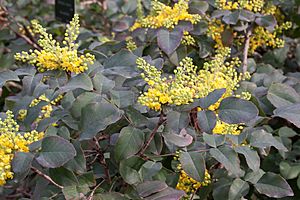Creeping Oregon grape facts for kids
Quick facts for kids Creeping Oregon grape |
|
|---|---|
 |
|
| Mahonia repens | |
| Scientific classification | |
| Genus: |
Mahonia
|
| Species: |
repens
|
| Synonyms | |
|
|
The Creeping Oregon Grape (scientific name: Mahonia repens) is a cool plant found in western North America. People also call it creeping mahonia or creeping barberry. It grows in places like the Rocky Mountains and stretches from British Columbia and Alberta in Canada all the way down to Arizona and New Mexico in the United States. You can also find it in California and Nevada.
Contents
About Creeping Oregon Grape
The Creeping Oregon Grape is a type of small shrub. It has bright yellow flowers that bloom in the middle of spring. Later, in early summer, it grows pretty blue berries. Even though it's an evergreen plant, its leaves turn a lovely bronze color in the fall. This plant can grow in many different places, from low areas around 300 meters (about 980 feet) up to high spots at 2,200 meters (about 7,200 feet).
How Scientists Classify It
Sometimes, scientists disagree on how to name plants. Some botanists think that Mahonia repens and all other Mahonia plants should actually be part of the Berberis family, which includes barberry plants. If they classify it this way, its scientific name becomes Berberis repens.
Also, some scientists believe it's a type of tall Oregon grape. In that case, they might call it Berberis aquifolium var. repens. It's like how different people might call the same thing by slightly different names!
Where It Grows
This plant is native to North America. You can find it in many U.S. states, including Minnesota, Nebraska, South Dakota, Colorado, Idaho, Montana, Oregon, Washington, Wyoming, New Mexico, Texas, Arizona, California, Nevada, and Utah. It also grows north of the border in the Canadian provinces of Alberta and British Columbia.
The Creeping Oregon Grape is quite common. It likes to grow in dry, flat areas, in forests, and on the lower parts of hills.
What It's Used For
The blue berries of the Creeping Oregon Grape are safe to eat. However, they can taste a bit bitter. People often use them to make tasty jellies.
Long ago, Native American tribes used this plant for many things. The Tolowa and Karuk people in Northwest California used the roots to make a special drink for coughs and to help their blood. Other tribes like the Hopi, Paiute, Navajo, Shoshoni, Blackfoot, and Cheyenne also used the plant. They used it for medicine, as food, and in their special ceremonies. Native Americans also used the wood from the plant's stem to make yellow dyes. They used these dyes to color their woven baskets.
Growing Creeping Oregon Grape

People often grow Creeping Oregon Grape in their gardens because it's a beautiful ornamental plant. It's great for natural landscaping and for gardens that save water, known as drought-tolerant gardens. It's also popular in wildlife gardens because it's a native plant that helps local animals.
This plant doesn't need much water. It can cover the ground well in shady spots or even brighter areas. If you have oak trees, planting Creeping Oregon Grape underneath them can help reduce the need for watering, which is good for the trees. Deer usually don't like to eat its berries or leaves.
Gardeners and landscape designers love this plant because it looks good all year. It's tough and can handle dry weather, frost, and heat. It makes a good ground cover, especially in cold places. Sometimes, in gardens or where they grow naturally, Creeping Oregon Grape can mix with the Oregon-grape (''Mahonia aquifolium''). When they mix, the new plants might not spread out as much as the pure Creeping Oregon Grape.

